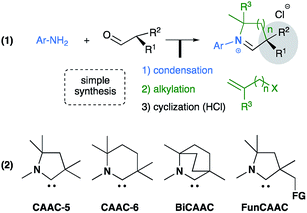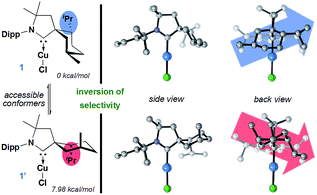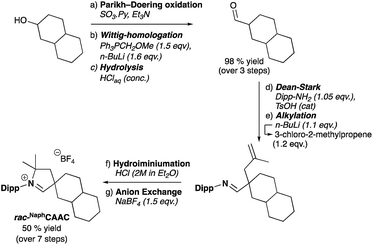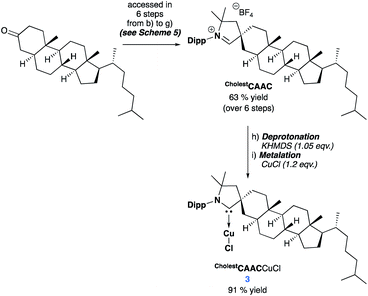 Open Access Article
Open Access ArticleThe debut of chiral cyclic (alkyl)(amino)carbenes (CAACs) in enantioselective catalysis†
Delphine
Pichon
 a,
Michele
Soleilhavoup
a,
Michele
Soleilhavoup
 b,
Jennifer
Morvan
b,
Jennifer
Morvan
 a,
Glen P.
Junor
a,
Glen P.
Junor
 b,
Thomas
Vives
b,
Thomas
Vives
 a,
Christophe
Crévisy
a,
Christophe
Crévisy
 a,
Vincent
Lavallo
a,
Vincent
Lavallo
 b,
Jean-Marc
Campagne
b,
Jean-Marc
Campagne
 c,
Marc
Mauduit
c,
Marc
Mauduit
 *a,
Rodolphe
Jazzar
*a,
Rodolphe
Jazzar
 *b and
Guy
Bertrand
*b and
Guy
Bertrand
 *b
*b
aEcole Nationale Supérieure de Chimie de Rennes, Univ Rennes, CNRS, ISCR – UMR 6226, F-35000 Rennes, France. E-mail: marc.mauduit@ensc-rennes.fr
bUCSD–CNRS Joint Research Chemistry Laboratory (UMI 3555), University of California San Diego, La Jolla, California 92093-0353, USA. E-mail: rjazzar@ucsd.edu; gbertrand@ucsd.edu
cInstitut Charles Gerhardt, UMR 5253 CNRS-UM2-UM1-ENSCM, 8 Rue l'Ecole Normale, 34296 Montpellier, France
First published on 6th July 2019
Abstract
The popularity of NHCs in transition metal catalysis has prompted the development of chiral versions as electron-rich neutral stereodirecting ancillary ligands for enantioselective transformations. Herein we demonstrate that cyclic (alkyl)(amino)carbene (CAAC) ligands can also engage in asymmetric transformations, thereby expanding the toolbox of available chiral carbenes.
1. Introduction
The success of stable N-heterocyclic carbenes (NHCs) as ligands for transition metal catalysts, and as organocatalysts in their own right, has triggered the development of chiral versions.1–3 Surprisingly, as recently noted by Glorius and co-workers,4 despite the existence of a variety of stable heterocyclic carbenes,5 only diaminocarbenes, namely imidazol-2-ylidenes,6 imidazolidin-2-ylidenes7 and 1,2,4-triazol-5-ylidenes8 have been used as ligands for enantioselective transformations. In 2005 our group discovered cyclic (alkyl)(amino)carbenes (CAACs).9,10 We and others have demonstrated that their unique electronic (more σ-donating and π-accepting than NHCs) and steric properties allow for the improvement of known catalytic processes (Ru,11 Pd,9,12 and Rh13) as well as promoting novel reactions with coinage metals (Cu14 and Au15). The direct protonated precursors of CAACs are readily available in one pot from an aldehyde and a primary amine (Scheme 1(1)).16 We have shown that our versatile synthetic methodology facilitates access to a library of 5-membered (CAAC-5), 6-membered (CAAC-6),12 bicylic (BiCAAC)17 and even bifunctional CAACs (FunCAAC)14b (Scheme 1(2)). Of particular importance, the CAAC family features a quaternary carbon adjacent to the carbene carbon, thus allowing the introduction of a chiral center in closer proximity to the active site than NHCs. Herein, we report the first examples of chiral CAAC ligands in asymmetric catalysis.In our initial paper on CAACs,9 we showed that the enantiopure L-MenthCAAC could be prepared without time-consuming enantio- or diastereoselective separation from the inexpensive (−)-menthol (Scheme 2). The key step of the synthesis was based on the well-known propensity of relatively bulky reactants to approach the cyclohexane moiety selectively from the equatorial direction.
2. Results and discussion
Years ago, we tested L-MenthCAAC transition metal complexes in a variety of asymmetric catalytic reactions without any success. Given our recent mechanistic work on copper-catalysis, we decided to revive this topic. We considered benchmarking the L-MenthCAAC in the copper-catalysed Asymmetric Conjugate Borylation (ACB) reaction. Over the past decade, this chemical transformation has emerged as a stalwart method for the preparation of chiral organoboron building blocks, which are sought after in organic synthesis.18 Although pioneered by Yun19 and others using chiral phosphine ligands,18d Fernández,20 Hoveyda21 and others18d have successfully shown that carbene ligands, specifically NHCs, could also be utilized in this process.As can be seen in Scheme 3, although the L-MenthCAAC copper complex 1 was found to be highly active in the addition of bis(pinacolato)diboron (B2pin2) to various α,β-unsaturated esters, an almost complete lack of asymmetric induction was observed. In comparison, the known non C2-chiral NHC copper complex 2,22 derived from (S)-1-(naphthalen-1-yl)ethan-1-amine, gave a 55% ee for the borylated adduct P1. Examining the X-ray crystal structure of 1,9 we expected some asymmetric induction since for many years we believed that a conformational inversion of the menthyl ring was energetically inaccessible. However, we recently found that in the solid state the menthyl group of the L-MenthCAAC amine adduct L-MenthCAACNH existed as the other conformer with the methyl and isopropyl substituents in axial position (Scheme 4).23 We were able to confirm with DFT calculations that the inverted menthyl conformer is also readily accessible in complex 1 (Fig. 1). The existence of the two conformers 1 and 1′ readily explains the lack of asymmetric induction since they have antagonistic stereo-inducing effects.
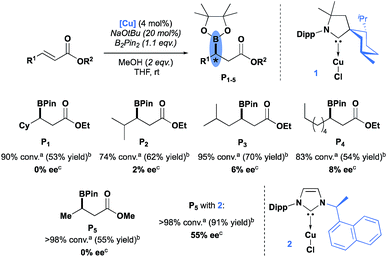 | ||
| Scheme 3 Comparing L-MenthCAACCuCl 1 and NHC–CuCl 2 in the Asymmetric Conjugate Borylation (ACB) reaction. aDetermined by 1H NMR spectroscopy using mesitylene as an internal standard. bIsolated yield after SiO2 purification. cDetermined by GC on a chiral stationary phase (see ESI for details†). | ||
 | ||
| Scheme 4 Conformational inversion of the menthyl ring.23 | ||
To circumvent this issue, we sought to prepare a more rigid chiral CAAC. Among the number of readily available molecules derived from the chiral pool, we selected the steroid backbone for its bulk, structural diversity, and tunability. We also reasoned that owing to a three-dimensional skeleton composed of four fused rings (three six-member cyclohexane rings – A, B, C- and one five-member cyclopentane ring D), this steroid motif would provide the desired rigid structural features while keeping the chirality intact during the synthesis (Fig. 2).
Before proceeding further, we confirmed that our synthetic methodology16 extends to the readily available decahydronaphthalene, a model substrate mimicking the first two fused cyclohexane (A and B) rings of a steroid skeleton (Scheme 5). CAAC-decahydronaphthyl iminium rac-NaphCAAC was obtained in 7 steps and 50% yield as a white powder.
Reassured by these results, we applied the same synthetic strategy to 5α-cholestan-3-one, an inexpensive enantiopure steroid derived from coprostanol (Scheme 6). The CAAC-cholestanyl iminium CholestCAAC was obtained in 6 steps and 63% yield as a white fluffy powder.24 The corresponding copper complex 3 was prepared by deprotonation of the CholestCAAC iminium with KHDMS followed by addition of copper chloride in THF. Single crystals were obtained by slow diffusion of diethyl ether in acetonitrile, and an X-ray diffraction study confirmed the formation of CholestCAACCuCl complex 3 (Fig. 3). It crystallized in the P21 space group with one molecule in the asymmetric unit cell.
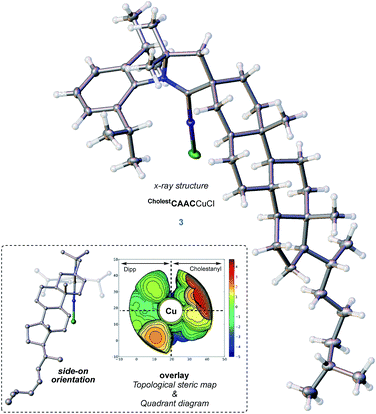 | ||
| Fig. 3 X-ray crystal structure of 3 (top) with the side-on orientation (omitting hydrogen for clarity) and an overlaid topological steric map with a quadrant diagram. | ||
The absolute stereochemistry was conclusively established using anomalous dispersion with a Flack parameter of 0.002(7) from refinement. The X-ray data of 3 show a distinctive orientation of the cholestanyl backbone, which gives rise to the topographic steric map showed in Fig. 3.25,26 As can be seen, the corresponding quadrant diagram could support facial stereoselectivity in catalyst-substrate adducts.
We next evaluated complex 3 in the ACB reaction (Scheme 7). As with L-MenthCAACCuCl 1, the steroid copper complex CholestCAACCuCl 3 efficiently catalyzes the addition of B2pin2 to various β-substituted α,β-unsaturated esters, affording the corresponding 1,4-adducts in moderate to good isolated yields (47 to 77%). More importantly, we were pleased to observe enantio-inductions with enantioselectivities reaching 55%.
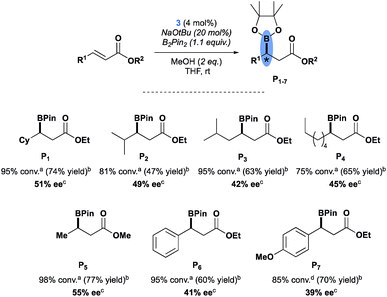 | ||
| Scheme 7 Evaluation of CholestCAACCuCl complex 3 in ACB reaction. aDetermined by 1H NMR spectroscopy using mesitylene as an internal standard. bIsolated yield after SiO2 purification. cDetermined by GC on a chiral stationary phase (see ESI for details†). dAnthracene was used as internal standard. | ||
3. Conclusions
This work rationalizes the inability of L-MenthCAAC to induce enantiomeric excess, and indicates that upon providing the right steric environment, the use of chiral CAACs should not be overlooked in metal-catalyzed asymmetric transformations. This new family of stereo-directing chiral carbene ligands are readily available from inexpensive precursors belonging to the chiral pool, and it is noteworthy that the chirality is not restricted to chiral amines (as is the case of NHCs), but extends to chiral aldehydes, a much larger feedstock.Conflicts of interest
There are no conflicts to declare.Acknowledgements
This work was supported by the U.S. Department of Energy, Office of Science, Basic Energy Sciences, Catalysis Science Program, under Award # DE-SC0009376, and the Agence Nationale de la Recherche (ANR-16-CE07-0019 – Hel-NHC) Thanks are due to the Alfred P. Sloan Foundation's University Centre for Exemplary Mentoring and the National Science Foundation Graduate Research Fellowship Program under Grant No. DGE-1650112 (G. P. J.), and to the National Science Foundation (V. L. – Grant # CHE-1455348). Any opinions, findings, and conclusions or recommendations expressed in this material are those of the author(s) and do not necessarily reflect the views of the National Science Foundation. We also greatly acknowledge the Region Bretagne for the ARED 2018, (“Biometa”, N° 601), and Rennes-Metropole for supporting international PhD mobility (D. P.). MM and TV thank Shimadzu and Chiral Technology for their support in the separation of chiral molecules by Supercritical Fluid Chromatography (SFC) technology.Notes and references
- (a) J. C. Sheehan and D. H. Hunneman, J. Am. Chem. Soc., 1966, 88, 3666–3667 CrossRef CAS; (b) D. Enders, H. Gielen, G. Raabe, J. Runsink and J. H. Teles, Chem. Ber., 1996, 129, 1483–1488 CrossRef CAS; (c) W. A. Herrmann, L. J. Goossen, C. Köcher and G. R. J. Artus, Angew. Chem., Int. Ed., 1996, 35, 2805–2807 CrossRef CAS; (d) M. T. Powell, D. R. Hou, M. C. Perry, X. Cui and K. Burgess, J. Am. Chem. Soc., 2001, 123, 8878–8879 CrossRef CAS; (e) T. J. Seiders, D. W. Ward and R. H. Grubbs, Org. Lett., 2001, 3, 3225–3228 CrossRef CAS.
- For reviews: (a) F. Wang, L.-J. Liu, W. Wang, S. Li and M. Shi, Coord. Chem. Rev., 2012, 256, 804–853 CrossRef CAS; (b) M. Zhao, Y.-T. Zhang, J. Chen and L. Zhou, Asian J. Org. Chem., 2018, 7, 54–69 CrossRef CAS; (c) J. Ouyang and J. Crassous, Coord. Chem. Rev., 2018, 376, 533–547 CrossRef CAS; (d) D. M. Flanigan, F. Romanov-Michailidis, N. A. White and T. Rovis, Chem. Rev., 2015, 115, 9307–9387 CrossRef CAS PubMed; (e) A. Grossmann and D. Enders, Angew. Chem., Int. Ed., 2012, 51, 314–325 CrossRef CAS.
- Selected examples of chiral NHC in: – Au catalysis – (a) Y.-M. Wang, C. N. Kuzniewski, V. Rauniyar, C. Hoong and F. D. Toste, J. Am. Chem. Soc., 2011, 133, 12972–12975 CrossRef CAS; (b) Y. Matsumoto, K. B. Selim, H. Nakanishi, K. Yamada, Y. Yamamoto and K. Tomioka, Tetrahedron Lett., 2010, 51, 404–406 CrossRef CAS; (c) C. Bartolome, D. García-Cuadrado, Z. Ramiro and P. Espinet, Inorg. Chem., 2010, 49, 9758–9764 CrossRef CAS; (d) S. Handa and L. M. Slaughter, Angew. Chem., Int. Ed., 2012, 51, 2912–2915 CrossRef CAS ; – Cu catalysis – ; (e) S. Drissi-Amraoui, M. Morin, C. Crévisy, O. Baslé, R. Marcia de Figueiredo, M. Mauduit and J.-M. Campagne, Angew. Chem., Int. Ed., 2015, 54, 11830–11834 CrossRef CAS ; – Pd catalysis – ; (f) E. P. Kündig, T. M. Seidel, Y. X. Jia and G. Bernardinelli, Angew. Chem., Int. Ed., 2007, 46, 8484–8487 CrossRef ; – Rh catalysis – ; (g) J. H. Kim, S. Greßies, M. Boultadakis-Arapinis, C. Daniliuc and F. Glorius, ACS Catal., 2016, 6, 7652–7656 CrossRef CAS . – Ru catalysis – ; (h) A. Kannenberg, D. Rost, S. Eibauer, S. Tiede and S. Blechert, Angew. Chem., Int. Ed., 2011, 50, 3299–3302 CrossRef CAS.
- D. Janssen-Mueller, C. Schlepphortst and F. Glorius, Chem. Soc. Rev., 2017, 46, 4845–4854 RSC.
- For reviews, see: (a) A. Vivancos, C. Segarra and M. Albrecht, Chem. Rev., 2018, 118, 9493–9586 CrossRef CAS; (b) G. Guisado-Barrios, M. Soleilhavoup and G. Bertrand, Acc. Chem. Res., 2018, 51, 3236–3244 CrossRef CAS; (c) M. Melaimi, M. Soleilhavoup and G. Bertrand, Angew. Chem., Int. Ed., 2010, 49, 8810–8849 CrossRef CAS.
- A. J. Arduengo III, R. L. Harlow and M. Kline, J. Am. Chem. Soc., 1991, 113, 361–363 CrossRef.
- A. J. Arduengo III, J. R. Goerlich and W. J. Marshall, J. Am. Chem. Soc., 1995, 117, 11027–11028 CrossRef.
- D. Enders, K. Breuer, G. Raabe, J. Runsink, J. H. Teles, J. P. Melder, K. Ebel and S. Brode, Angew. Chem., Int. Ed., 1995, 34, 1021–1023 CrossRef CAS.
- V. Lavallo, Y. Canac, C. Präsang, B. Donnadieu and G. Bertrand, Angew. Chem., Int. Ed., 2005, 44, 5705–5709 CrossRef CAS.
- For reviews on CAACs see: (a) M. Melaimi, R. Jazzar, M. Soleihavoup and G. Bertrand, Angew. Chem., Int. Ed., 2017, 56, 10046–10068 CrossRef CAS; (b) M. Soleilhavoup and G. Bertrand, Acc. Chem. Res., 2015, 48, 256–266 CrossRef CAS; (c) M. Melaimi, M. Soleilhavoup and G. Bertrand, Angew. Chem., Int. Ed., 2010, 49, 8810–8849 CrossRef CAS; (d) S. Roy, K. C. Mondal and H. W. Roesky, Acc. Chem. Res., 2016, 49, 357–369 CrossRef CAS; (e) U. S. D. Paul and U. Radius, Eur. J. Inorg. Chem., 2017, 3362–3375 CrossRef CAS.
- (a) V. M. Marx, A. H. Sullivan, M. Melaimi, S. C. Virgil, B. K. Keitz, D. S. Weinberger, G. Bertrand and R. H. Grubbs, Angew. Chem., Int. Ed., 2014, 54, 1919–1923 CrossRef; (b) D. R. Anderson, V. Lavallo, D. J. O'leary, G. Bertrand and R. H. Grubbs, Angew. Chem., Int. Ed., 2007, 46, 7262–7265 CrossRef CAS; (c) D. R. Anderson, T. Ung, G. Mkrtumyan, G. Bertrand, R. H. Grubbs and Y. Schrodi, Organometallics, 2008, 27, 563–566 CrossRef CAS; (d) V. M. Marx, A. H. Sullivan, M. Melaimi, S. C. Virgil, B. K. Keitz, D. S. Weinberger, G. Bertrand and R. H. Grubbs, Angew. Chem., Int. Ed., 2015, 54, 1919–1923 CrossRef CAS.
- C. M. Weinstein, G. P. Junor, D. R. Tolentino, R. Jazzar, M. Melaimi and G. Bertrand, J. Am. Chem. Soc., 2018, 140, 9255–9260 CrossRef CAS PubMed.
- (a) M. P. Wiesenfeldt, Z. Nairoukh, W. Li and F. Glorius, Science, 2017, 357, 908–912 CrossRef CAS PubMed; (b) Y. Wei, B. Rao, X. Cong and X. Zeng, J. Am. Chem. Soc., 2015, 137, 9250–9253 CrossRef CAS; (c) L. Tran, J. L. Fulton, J. C. Linehan, M. Balasubramanian, J. A. Lercher and R. M. Bullock, ACS Catal., 2019, 9, 4106–4114 CrossRef; (d) Z. Nairoukh, M. Wollenburg, C. Schlepphorst, K. Bergander and F. Glorius, Nat. Chem., 2019, 11, 264–270 CrossRef CAS.
- (a) E. A. Romero, R. Jazzar and G. Bertrand, Chem. Sci., 2017, 8, 165–168 RSC; (b) J. Chu, D. Munz, R. Jazzar, M. Melaimi and G. Bertrand, J. Am. Chem. Soc., 2016, 138, 7884–7887 CrossRef CAS PubMed.
- (a) X. Hu, D. Martin, M. Melaimi and G. Bertrand, J. Am. Chem. Soc., 2014, 136, 13594–13597 CrossRef CAS; (b) R. Kinjo, B. Donnadieu and G. Bertrand, Angew. Chem., Int. Ed., 2011, 50, 5560–5563 CrossRef CAS; (c) X. Zeng, R. Kinjo, B. Donnadieu and G. Bertrand, Angew. Chem., Int. Ed., 2010, 49, 942–945 CrossRef CAS; (d) V. Lavallo, G. D. Frey, B. Donnadieu, M. Soleilhavoup and G. Bertrand, Angew. Chem., Int. Ed., 2008, 47, 5224–5228 CrossRef CAS; (e) L. Jin, D. S. Weinberger, M. Melaimi, C. E. Moore, A. L. Rheingold and G. Bertrand, Angew. Chem., Int. Ed., 2014, 53, 9059–9063 CrossRef CAS.
- (a) R. Jazzar, H. Liang, B. Donnadieu and G. Bertrand, J. Organomet. Chem., 2006, 691, 3201–3205 CrossRef CAS; (b) R. Jazzar, R. D. Dewhurst, J.-B. Bourg, B. Donnadieu, Y. Canac and G. Bertrand, Angew. Chem., Int. Ed., 2007, 46, 2899–2902 CrossRef CAS; (c) R. Jazzar, J.-B. Bourg, R. D. Dewhurst, B. Donnadieu and G. Bertrand, J. Org. Chem., 2007, 72, 3492–3499 CrossRef CAS PubMed; (d) X. Zeng, G. D. Frey, R. Kinjo, B. Donnadieu and G. Bertrand, J. Am. Chem. Soc., 2009, 131, 8690–8696 CrossRef CAS.
- E. Tomás-Mendivil, M. M. Hansmann, C. M. Weinstein, R. Jazzar, M. Melaimi and G. Bertrand, J. Am. Chem. Soc., 2017, 139, 7753–7756 CrossRef.
- (a) J. A. Schiffner, K. Muther and M. Oestreich, Angew. Chem., Int. Ed., 2010, 49, 1194–1196 CrossRef CAS; (b) E. C. Neeve, S. J. Geier, I. A. Mkhalid, S. A. Westcott and T. B. Marder, Chem. Rev., 2016, 116, 9091–9161 CrossRef CAS; (c) Q. Liu, B. Tian, P. Tian, X. Tong and G.-Q. Lin, Chin. J. Org. Chem., 2015, 35, 1–14 CrossRef; (d) K. Zheng, X. Liu and X. Feng, Chem. Rev., 2018, 118, 7586–7656 CrossRef CAS.
- (a) J. E. Lee and J. Yun, Angew. Chem., Int. Ed., 2008, 47, 145–147 CrossRef CAS; (b) H. Chea, H.-S. Sim and J. Yun, Adv. Synth. Catal., 2009, 351, 855–858 CrossRef CAS; (c) H. S. Sim, X. Feng and J. Yun, Chem.–Eur. J., 2009, 15, 1939–1943 CrossRef CAS; (d) X. Feng and J. Yun, Chem. Commun., 2009, 6577–6579 RSC.
- V. Lillo, A. Prieto, A. Bonet, M. M. Díaz-Requejo, J. Ramírez, P. J. Peŕez and E. Fernańdez, Organometallics, 2009, 28, 659–662 CrossRef CAS.
- J. M. O'Brien, K. S. Lee and A. H. Hoveyda, J. Am. Chem. Soc., 2010, 132, 10630–10633 CrossRef PubMed.
- (a) C. Jahier-Diallo, M. S. T. Morin, P. Queval, M. Rouen, I. Artur, P. Querard, L. Toupet, C. Crévisy, O. Baslé and M. Mauduit, Chem.–Eur. J., 2015, 21, 993–997 CrossRef CAS . For a higher ee, see: ; (b) J. K. Park, H. H. Lackey, M. D. Rexford, K. Kovnir, M. Shatruk and D. T. McQuade, Org. Lett., 2010, 12, 5008–5011 CrossRef CAS.
- D. Tolentino, S. Neale, C. Isaac, S. Macgregor, M. Whittlesey, R. Jazzar and G. Bertrand, J. Am. Chem. Soc., 2019, 141, 9823–9826 CrossRef CAS.
- Cholesterol derived NHCs have been reported: (a) L. Rakers, L. M. Martínez-Prieto, A. M. López-Vinasco, K. Philippot, P. W. N. M. van Leeuwen, B. Chaudret and F. Glorius, Chem. Commun., 2018, 54, 7070–7073 RSC; (b) L. Rakers, D. Grill, A. L. L. Matos, S. Wulff, D. Wang, J. Börgel, M. Körsgen, H. F. Arlinghaus, H.-J. Galla, V. Gerke and F. Glorius, Cell Chem. Biol., 2018, 25, 952–961 CrossRef CAS.
- H. Clavier and S. P. Nolan, Chem. Commun., 2010, 46, 841–861 RSC.
- Steric maps were extrapolated using the SambVca 2 web-based program developed by Cavallo and co-workers. F. Falivene, R. Credendino, A. Poater, A. Petta, L. Serra, R. Oliva, V. Scarano and L. Cavallo, Organometallics, 2016, 35, 2286–2293 CrossRef.
Footnote |
| † Electronic supplementary information (ESI) available: Experimental procedures, NMR spectra. CCDC 1919315. For ESI and crystallographic data in CIF or other electronic format see DOI: 10.1039/c9sc02810b |
| This journal is © The Royal Society of Chemistry 2019 |

